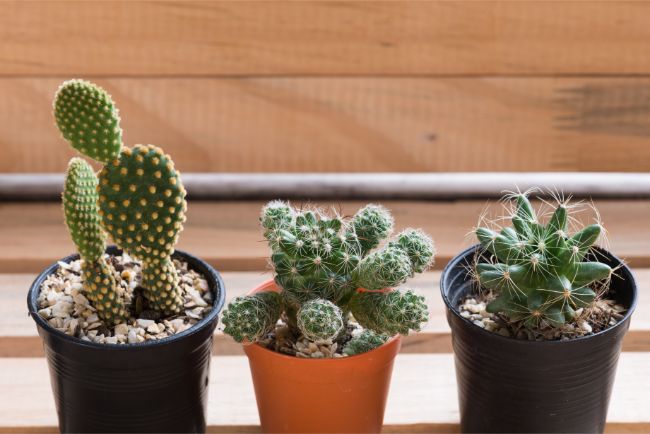Cacti are intriguing plants that sometimes seem like they are from another world. Not only are they unique in appearance, but cactus adaptations give them a remarkable ability to thrive in harsh desert landscapes where few other plants can survive. So what is it about cacti that makes them such strong survivalists in these hostile environments?
How are cacti adapted to the desert? Cacti have numerous anatomical and behavioral adaptations for absorbing and storing water, preventing water loss, protecting themselves from predators, limiting damage from the hot sun, saving their energy, requiring few resources, and attracting pollinators.
Read on to learn how every part of the cactus plant has become optimized for desert survival.
Cactus Adaptations – An Introduction
You may be interested in learning about these cactus adaptations out of curiosity or because you would like to better understand them so you can provide your cactus houseplants with the best care possible.
Regardless, you’re sure to be surprised by some of the amazing ways these hardy plants have become specialists in surviving some of the most foreboding environments on the planet.
Note that not all cacti are desert cacti, as there is a group of cacti known as jungle cacti that grow in tropical rainforests, which includes the Christmas cactus, epiphytic cacti such as Rhipsalis, and the night-blooming Hylocereus.
The focus of this article will be desert cacti and the different ways they have adapted to hot, arid environments.
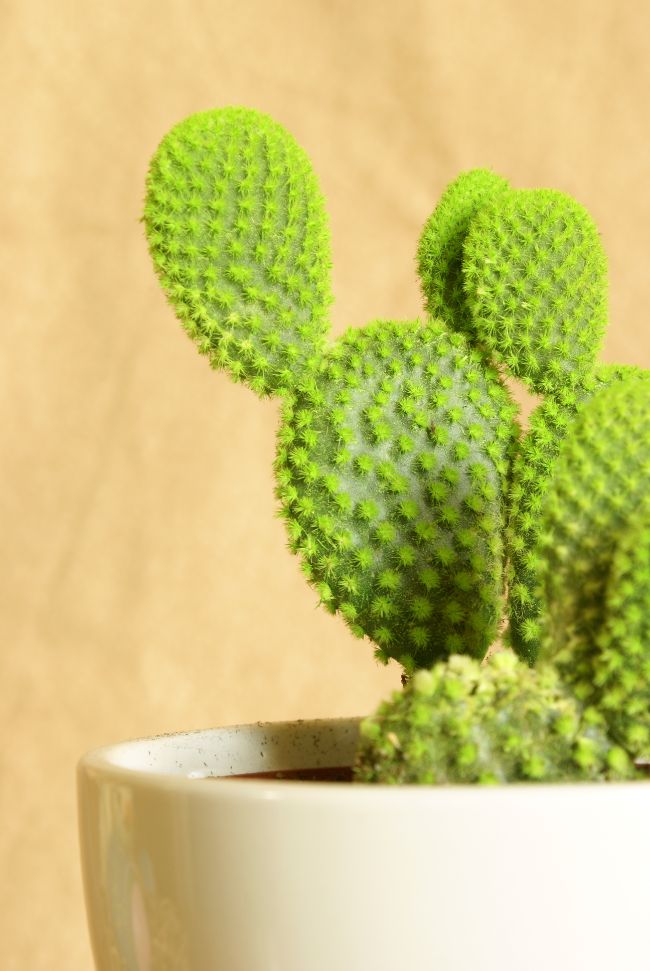
Cactus Roots Gather Water Quickly And Efficiently After Brief Desert Rains
Desert cacti live in arid regions that get very little precipitation. When it does rain, it comes in short bursts. So cactus adaptations to collect water quickly and efficiently before the moisture evaporates away in the dry air are essential for the plant to survive. There are two features of desert cactus roots that give them the ability to do this.
Shallow Root Systems
Most desert cacti have an extensive system of shallow roots that spread out widely near the surface of the soil, with some larger cacti such as the giant saguaro also having a deep taproot that anchors the plant and stores water.
A shallow root system allows cacti to absorb as much water as possible when it rains, as well as providing access to small amounts of moisture that may occur at the surface due to fog, mist, or morning dew.
Temporary Root Hairs
Another interesting way cactus roots harness precious water and prevent water loss is by sprouting temporary root hairs when it rains. These root hairs grow quickly, rapidly increasing the surface area of the root system that’s in contact with the soil.
Then, after the soil dries out and they are no longer needed, the root hairs die away. This prevents water loss back into the soil and saves the plant from having to use its energy to maintain them.
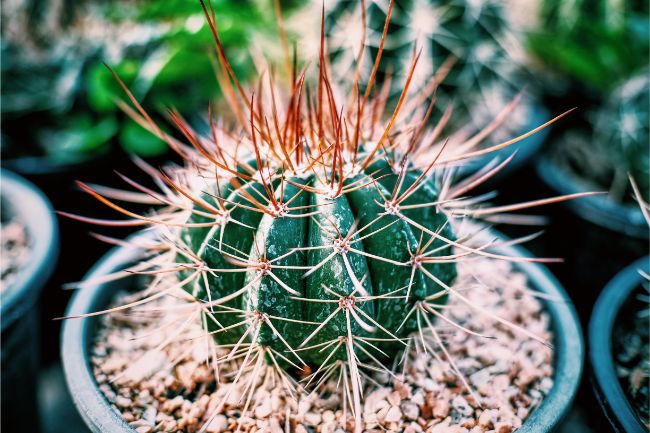
Why Don’t Cacti Have Leaves?
One of the most striking cactus adaptations is their lack of leaves. Although not all cacti are leafless, the species with leaves are limited to a small number of cacti belonging to three groups of quite unusual cacti: the genera Pereskia and Maihuenia and the subfamily Opuntioideae.
So why don’t most cacti have leaves?
It’s because of the process of photosynthesis and the requirement of having pores to take in carbon dioxide and give off oxygen that cacti dropped the need for leaves.
A plant pore is called a stoma, and multiple pores are called stomata. They open up to take in carbon dioxide and give off oxygen during photosynthesis and close when there’s insufficient sunlight.
Usually, leaves are where most of a plant’s photosynthesis takes place, with their green color being due to an abundance of light-absorbing chlorophyll.
The flat shape of common, non-succulent leaves maximizes their exposure to sunlight by providing a large amount of surface area compared to how much internal tissue they have. This large surface area also means that leaves have a lot of stomata.
The problem for plants trying to survive in hot, arid climates, where water evaporates quickly, is that when their stomata open to facilitate photosynthesis, water vapor escapes.
So desert cacti have addressed this water loss by eliminating leaves altogether and moving the job of conducting photosynthesis to their thick stems, where the exposure to the atmosphere of tissues holding the water needed for photosynthesis is minimized.
CAM Photosynthesis Minimizes Water Loss Through Stomata
In addition to switching the primary location for photosynthesis from leaves to their stems, cacti (along with many other succulents) have adopted a method of conducting photosynthesis that’s different from the norm called Crassulacean Acid Metabolism, or CAM photosynthesis. And the reason for this change is, once again, to minimize the loss of moisture through stomata.
CAM photosynthesis allows the plant to open its stomata at night, when temperatures are cooler and the evaporation rate of water is lower.
The plant stores the carbon dioxide it takes up in the form of malic acid, so that during daylight hours, it can carry out photosynthesis with the stored carbon dioxide and the stomata can remain closed.
Cactus Stems Are The Ultimate Experts At Storing Water And Minimizing Its Loss
When it comes to cactus adaptations, the stems have developed a number rather ingenious ways to adapt to harsh arid climates. They use their unique inner cell structures and features on their outer surfaces to store and preserve water.
Succulence
The cortical layer, or cortex, of a plant stem is the area just inside the outer layer of cells known as the epidermis, and the cortical layer of cacti is unique among plants in having an inner region that serves as a water reservoir, where walls of the water-holding cells are thin and flexible.
These large cells fill up with water for storage and then release it to the cells that need it in times of drought. Additionally, in many types of cacti, these special cortical cell walls are undulating rather than smooth, so the cells can collapse in on themselves and release the water more efficiently.
These water-storage cells in the stems of cacti are filled with mucilage, the gooey substance found in many succulent plants that is very good at binding water and preventing it from evaporating. In cacti, these mucilage cells are often aligned into canals.
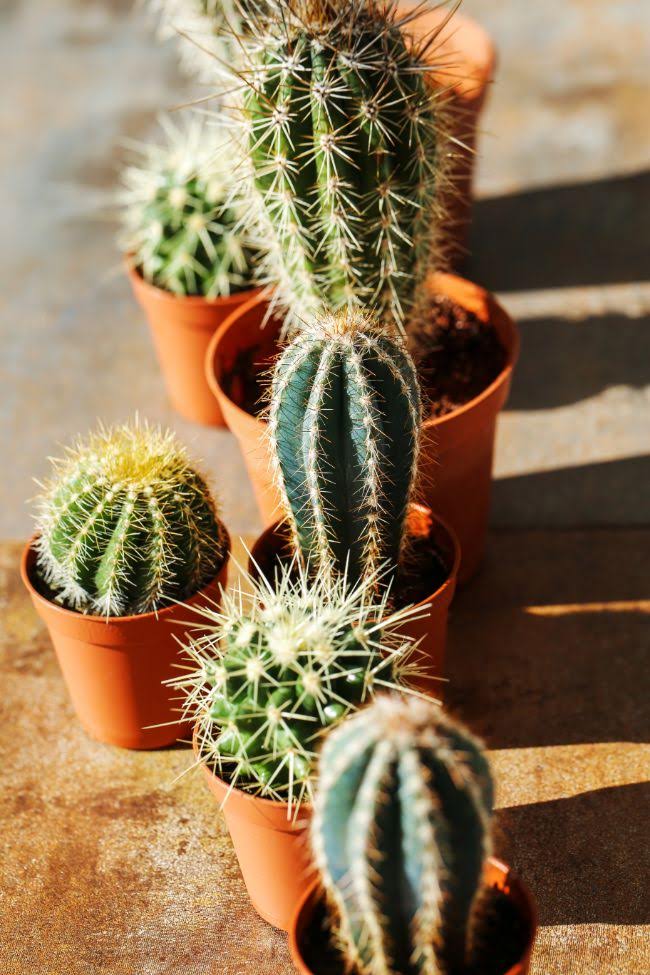
Enlarged Cortical Layer
Cacti also have thicker cortical layers than any other plants. And this cortical layer further differs from the cortex of other types of succulents in its ability to transfer water and plant sugars produced by photosynthesis due to vascular tissue that is distributed throughout it.
This means that the plant doesn’t have to depend on the slower process of cell-to-cell diffusion of vital substances. This efficiency in transference is what allows cactus stems to become so large in diameter and thus store larger volumes of water.
Larger Volumes Of Stored Water Help Protect Cacti From Temperature Extremes
Fascinatingly, large cacti such as saguaros – which, when fully hydrated, become over 90% water – receive a protective, stabilizing effect from all that water.
During the day, heat absorbed into the plant’s tissue brings the internal temperature up a bit, but the water’s thermal inertia keeps it from rising as high as the lethal external temperatures that can occur in the desert. Then, when the air cools down at night, the internal heat slowly radiates back out but keeps the tissue from freezing on cold winter nights.
The Accordion Effect
Most cactus stems have a pleated surface. They may be covered with protuberances known as tubercles, or the tubercles may be lined up and fused together to form ribs. Tubercles are actually modified leaf bases called podaria, and each podarium has its own cluster of spines.
Cactus tubercles and ribs play an important role in water storage and retention, as they allow the stem to expand to increase the volume of moisture it can hold without stretching or bruising and then retract as the stem loses water, which minimizes the amount of surface area that’s exposed to direct sunlight.
Impervious Skin
The stems of cacti often have a waxy coating, or cuticle, that helps retain moisture inside the plant. The cuticle covering cactus stems is waterproof and very thick compared to the outer skin of other plants.
Cactus Plant Shapes Maximize Internal Volume
Desert cacti have shapes, or what botanists call growth habits, that are very different from anything else in the plant world, and they can be pretty odd looking!
If you think about it, it makes sense for plants that need to store water for survival to grow in shapes that provide the highest possible internal volume while minimizing the surface area that’s exposed to the hot sun. That’s why cacti have such thick stems and a tendency toward round, columnar, cylindrical and barrel-shaped growth habits.
Slow Metabolism Allows Cacti To Save Energy
Without leaves serving as factories for plant growth, desert cacti have less green tissue conducting photosynthesis. As a result, they are slow growers. A slow metabolism is one of the most essential cactus adaptations for surviving in the desert, where conditions are difficult and uncertain, for several reasons:
- Energy Conservation. Rather than expending their energy on developing the foliage that other plants need to maintain their more rapid growth, cacti can concentrate on maintaining the structures and habits that help them survive.
- Fewer Needs. Desert landscapes often have poor soil fertility in addition to little rainfall, so taking it easy and being able to survive with fewer resources is a great advantage for cacti to have developed.
- Long Lifespans. Cacti are in it for the long haul, with typical lifespans ranging from 10 to 200 years! Thanks to their slow metabolism, they’re able to keep going for longer, which helps to ensure that at some point, the plant will manage to reproduce.
Learn more about the growth rate of cacti here
Spines Play Vital Roles In Protecting Cacti And Collecting Water
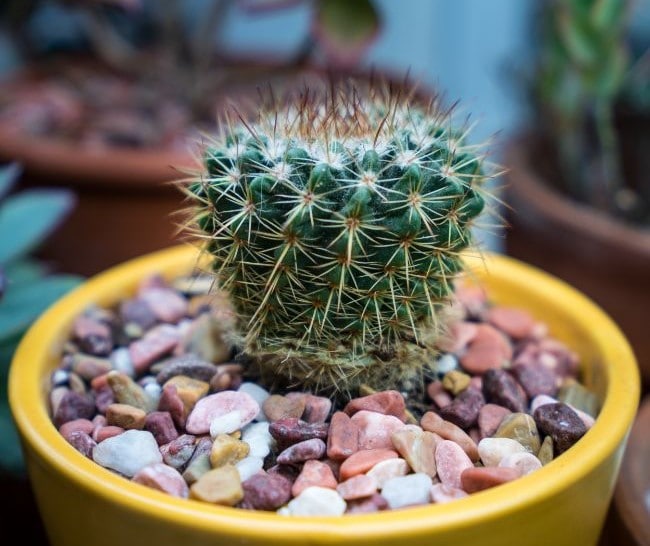
In addition to their odd growth habits and lack of leaves, another one of the remarkable cactus adaptations is their spines. All cacti produce spines, although a few types only have them when they are young.
These spines come in many shapes and sizes. They can be long or short, stout and spiky or fine and hair-like, bristly, woolly, needle-like, barbed, hooked, straight, or curved. And they vary in color.
Now some may argue that it’s not really correct to say that cacti have no leaves because spines are actually modified leaves. But cactus spines could hardly be more different from regular leaves – not only in appearance but also in function and makeup, since spines consist of hard fibers made largely of dead cells, as opposed to the living cells in green leaves that generate food for the plant through photosynthesis.
Protection From Loss Of Green Tissue
One rather obvious function of cactus spines is to protect the plant from predators. This may seem like overkill, but this level of protection is essential for cactus survival. Since they have less green tissue and are already such slow growers, having animals chomping off parts can cause significant setbacks to their growth that may eventually lead to the plant’s demise.
Protection from predators, however, is not the only way cactus spines help the plant survive in harsh growing conditions. In fact, there are different types of cactus spines, and some of them don’t have a deterrent function at all.
Surprisingly, cactus spines actually play several very important roles in helping the plant conserve water and protect itself from the harsh effects of the sun – and they even help collect moisture, too!
Throwing Shade
In addition to warding off herbivores, desert plants also need to protect themselves from the harmful effects of the sun, which include sunburn damage to the outer surface from light that’s too intense, chlorophyll bleaching, permanent damage to the plant’s DNA, rapid dehydration, and overheating to the point that the plant cells are essential being cooked by the sun.
With their thin profile, it wouldn’t seem that spines could work well as a shade umbrella. However, there are a couple of ways that spines can be quite effective as a protective sunblock:
- Power In Numbers. One slender spine doesn’t throw much shade; but when there are lots of them, spines can provide a significant amount of protection from the sun.
- Light Colors. White and other pale-colored spines help limit sun damage by reflecting sunlight.
Airflow Regulation
Another interesting way that spines help cacti survive desert environments is by regulating the airflow around the plant. By breaking up the airflow, spines create a layer of air – or what could be called a microclimate – that serves as insulation against changes in temperature as well as accelerated evaporation brought on by hot air or wind.
Moisture Collection
Perhaps the most surprising way that spines help cacti survive in the desert is by collecting moisture for the plant. Whenever there is rain, fog, mist, or dew, the moisture in the atmosphere condenses on the spines and then drips down to the base of the plant, where the cactus’s shallow roots absorb it.
Learn more about why cacti have spines here
The Importance Of Areoles For Desert Survival
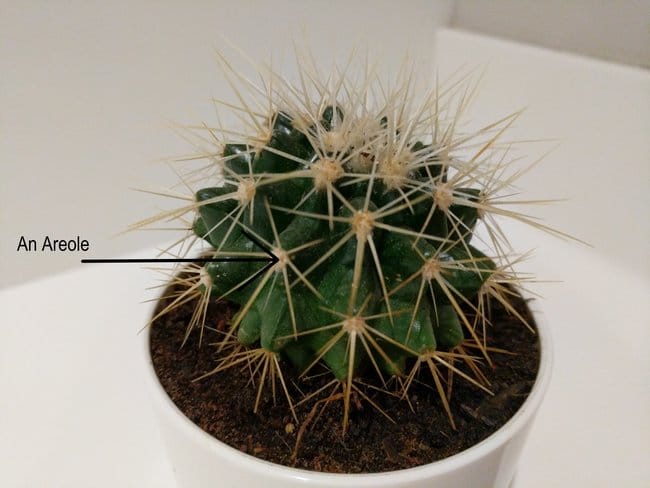
So spines are modified leaves, and they grow out of organs called areoles that are modified branches. Areoles are a distinguishing feature of a cactus plant, meaning that if a plant has areoles, it must be a cactus and if it doesn’t have areoles, it can’t be a cactus. Areoles are small raised cushions out of which spines, flowers, and branches grow.
Areoles are a key adaptation of cacti because they gave rise to the spine clusters that are so important to cactus survival, and they can cover the plant with spines much more effectively than plants that grow spines directly from their stems.
The spine clusters they produce may have central and radial spines as well as different types of spines, often including many small hairs or the tiny, vicious, barbed spines known as glochids.
Cactus Flower Adaptations For Attracting Pollinators In The Desert
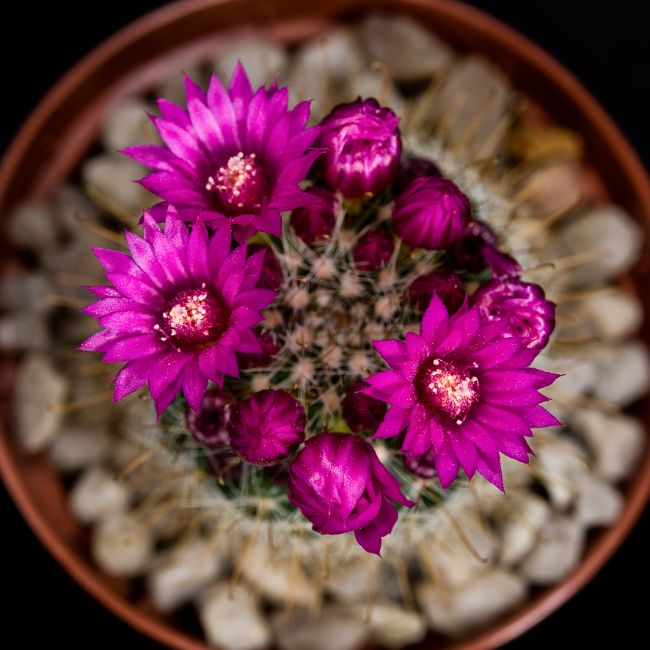
Different types of cacti produce various types of flowers depending on what kind of pollinators they are trying to attract. While the most common cactus pollinators are bees, cactus flowers may also be designed to attract butterflies, moths, hummingbirds, and, in the desert, bats.
Bat pollination is not very common among flowering plants. But cacti have a high proportion of species that strive to attract bats, which can travel considerable distances between sparse populations of cacti in desert and semi-desert environments.
These cacti produce flowers that tend to open in the evening and at night, are less brightly colored than is typical of other cactus flowers, exude a musty smell, and produce a large amount of sugary nectar.
I hope you have enjoyed this look into the amazing cactus adaptations that help these plants survive in desert environments. If you’d like to learn more about the interesting features of cacti, why not have a look at some of my other articles below.

